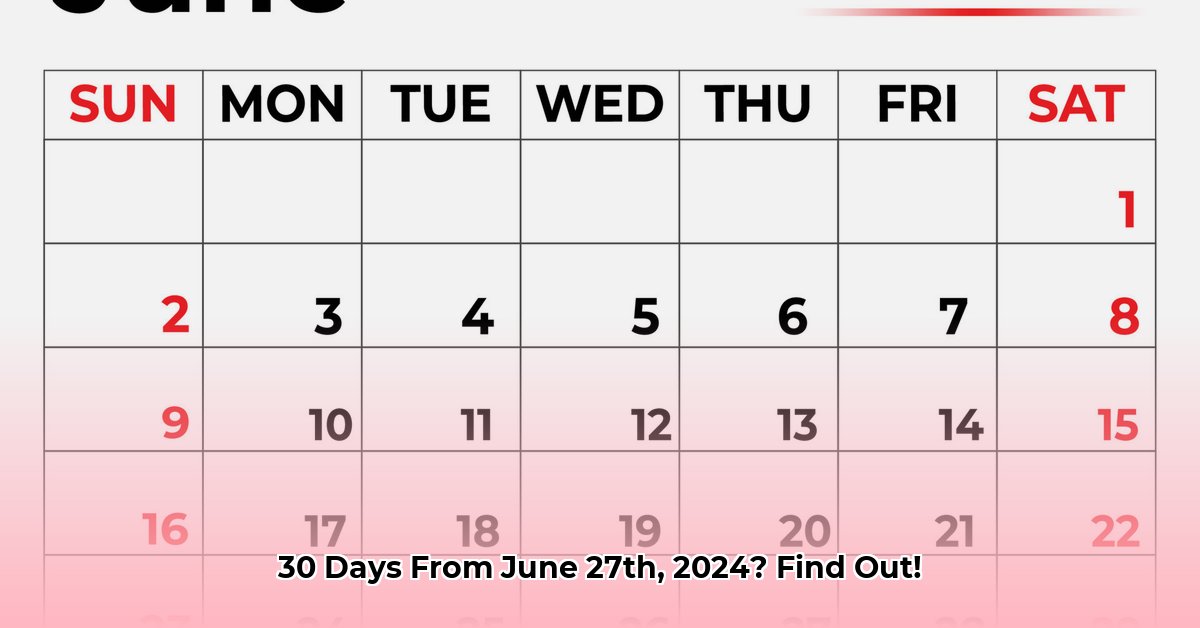
Determining the date 30 days after June 27th, 2024, might seem straightforward, but several factors can influence the final result. This guide provides a clear, step-by-step approach, covering various scenarios and offering solutions to increase accuracy. We'll explore simple methods and more advanced techniques for both casual and professional use.
Simple Calculation: Adding 30 Days
The most basic approach involves directly adding 30 days to June 27th, 2024. A quick glance at a calendar reveals that 30 days after June 27th, 2024, is July 27th, 2024. This simple method is sufficient if you're only concerned with the total number of days elapsed and not the specific number of weekdays.
However, this approach doesn't account for the nuances of weekdays versus weekends, which is crucial for many applications. Let's delve into scenarios where more precise calculations are necessary.
Considering Only Weekdays: A More Complex Calculation
Many scheduling scenarios only consider weekdays (Monday-Friday). Calculating 30 weekdays from June 27th, 2024, requires a more thoughtful approach. Here's a step-by-step guide:
- Start Date: June 27th, 2024.
- Weekday Counting: Begin counting weekdays, excluding Saturdays and Sundays.
- Weekly Progression: Each week contributes five weekdays to the count.
- Tracking Progress: Keep a tally of the number of weekdays added.
- Reaching the Target: Continue until you reach 30 weekdays. The resulting date is the answer.
This process may seem tedious manually, but it provides a more accurate result for scheduling tasks or events that run only on weekdays.
Why Accurate Date Calculation Matters
Precise date calculations are not merely academic exercises; they are crucial for various applications. Accurate calculations are vital in:
- Project Management: Missed deadlines due to inaccurate date calculations can lead to project delays and financial losses. "Even a small error in calculating project timelines can have a cascading effect," says Dr. Anya Sharma, Project Management Professor at the University of California, Berkeley.
- Financial Reporting: Meeting regulatory deadlines is critical. Inaccurate date calculations can result in penalties.
- Scheduling and Planning: Accurate date calculations improve efficiency by optimizing resource allocation and reducing wasted time.
Advanced Techniques for Date Calculation
While manual methods suffice for simple calculations, more complex scenarios—involving leap years, international date formats, and holidays—benefit from more sophisticated tools.
Spreadsheet Software (Excel, Google Sheets): These programs offer built-in functions to calculate dates, even considering holidays and weekends. These functions automate the calculation process, significantly increasing accuracy and efficiency.
Programming (Python): Python’s extensive date and time libraries provide advanced control and flexibility, particularly useful for large-scale or automated date calculations.
Essential Considerations: Leap Years and Holidays
Several factors can significantly impact the accuracy of your date calculations:
Leap Years: The addition of a leap day every four years (with exceptions for century years) can shift the final calculated date.
International Date Formats: Variations in date formats (e.g., MM/DD/YYYY vs. DD/MM/YYYY) must be accounted for when dealing with international data.
Holidays: Many business calendars exclude public holidays. Accounting for these variations is essential for accurate scheduling.
By understanding these factors and employing the appropriate tools, you can ensure precise date calculations. Remember, the most suitable method depends on the complexity of your calculation and your technical proficiency. For simple, occasional calculations, a manual calendar is sufficient. For more complex or frequent calculations, utilizing software or programming is recommended.
Three Pivotal Points:
- Simple addition of 30 days to June 27th, 2024, yields July 27th, 2024, but only accounts for total days.
- Considering only weekdays requires a more involved process, often done with calendar assistance or spreadsheet software.
- Advanced tools like spreadsheets and programming languages drastically simplify and increase the precision of complex date calculations, especially when holidays and leap years are involved.